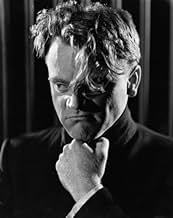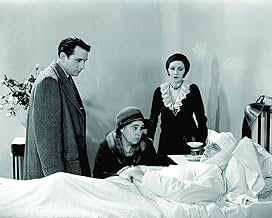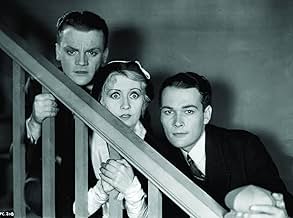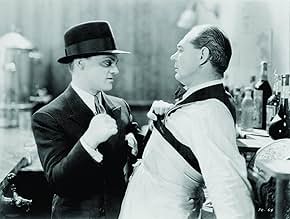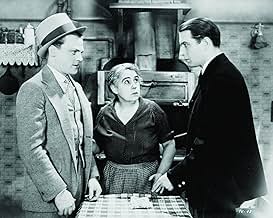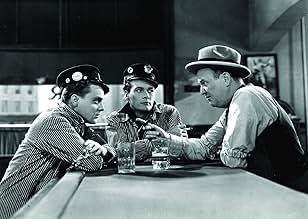अपनी भाषा में प्लॉट जोड़ेंAn Irish-American street punk tries to make it big in the world of organized crime.An Irish-American street punk tries to make it big in the world of organized crime.An Irish-American street punk tries to make it big in the world of organized crime.
- निर्देशक
- लेखक
- स्टार
- 1 ऑस्कर के लिए नामांकित
- 1 जीत और कुल 1 नामांकन
- Paddy Ryan
- (as Robert O'Connor)
- Goon
- (बिना क्रेडिट के)
- Dutch
- (बिना क्रेडिट के)
- Kitty
- (बिना क्रेडिट के)
- Tom as a Boy
- (बिना क्रेडिट के)
- Machine Gunner
- (बिना क्रेडिट के)
- Matt as a Boy
- (बिना क्रेडिट के)
- Miller
- (बिना क्रेडिट के)
- Molly Doyle
- (बिना क्रेडिट के)
- Nails' Girl
- (बिना क्रेडिट के)
फ़ीचर्ड समीक्षाएं
Through its passage in time element starting in 1909 Chicago, THE PUBLIC ENEMY plays in the biographical mode, displaying the origins of its main characters, Tom Powers and Matt Doyle, as boys (Junior Coughlan and Frankie Darro), leading to their adult lives (James Cagney and Edward Woods) as tough thugs. Tom Powers character, regardless of his fine upbringing, indicates he was born ... to be bad. He has a brother, Mike (Donald Cook) who knows of his activities, while their mother (Beryl Mercer) may suspect but overlooks his actions. As things start going well for Tom and Matt in the bootlegging racket under Paddy Ryan's (Robert Emmett O'Connor) leadership, Scheiner Burns, a rival gang leader, attempts on taking over Ryan's establishment, leading to more gun-play, especially for Tom, quick on the trigger, only to have things backfire on him.
If not the most famous of the early gangster films, THE PUBLIC ENEMY is one of the most revived. Quite frank in its actions, and adult for its intentions, much of the then so- called violence occurs out of camera range. Yet, whatever is displayed on film is something not to forget. These days, there isn't a year that goes where THE PUBLIC ENEMY isn't televised. Whenever a topic pertaining to THE PUBLIC ENEMY arises, it's not the story that immediately comes to mind, but Cagney's individual scenes consisting of squirting beer from his mouth into the bartender's face; Tom's cold-blooded killing of Putty Nose (the man who let him take the rap for a crime) while playing his last song on the piano; and Tom's off-screen shootout with a rival gang in a fancy nightclub, stumbling out in the pouring rain saying to himself, "I ain't so tough." All these scenes pale in comparison until reaching its most chilling climax ever recorded on film. Yet, the one where Tom, at the breakfast table, pushes a grapefruit into his mistress Kitty's (Mae Clarke) face, never has such a brief scene have such an long impact. Other than Clarke's famous few minutes of grapefruit glory, Mia Marvin (whose face resembling Maureen "Marcia Brady" McCormick from TV's 1970s sit-com, "The Brady Bunch") playing a slut named Jane, is one who gets her face slapped after getting Tom drunk enough to seduce him. The second billed Jean Harlow doesn't get any abuse from her leading man as did the other two actresses receiving no screen credit for their trouble. While Harlow's performance has been criticized as one of her worst, chances are her portrayal might have been intended to be enacted in that manner. Harlow's Gwen Allen is an uneducated blonde floozy with her gift for attracting men. What possibly hurts the film is not Harlow herself, but the inane dialog she recites, ("Oh Tommy, I can love you to death!". Joan Blondell's limitations on screen is mostly one involving her relation with Tom's pal, Matt. Edward Woods, whose has almost equal screen time with Cagney, is a Hollywood name very few recollect today. Several documentaries profiling gangster films have indicated Woods as the initial star of THE PUBLIC ENEMY with Cagney assuming the subordinate role, with director Wellman seeing an error with the casting and wisely having these actors switch roles. While a smart move on Wellman's part, he failed to switch roles on the boy actors who portrayed them, especially a keen observer noticing Frankie Darro playing Matt, not Junior Coughlan playing Tom, performing in the Cagney manner. Donald Cook, Beryl Mercer and Robert O'Connor appearing in subordinate roles, are essential with their parts, but never outshine Hollywood's finest movie thug, a/k/a Public Enemy, James Cagney, whose tougher roles, ANGELS WITH DIRTY FACES (1938) and WHITE HEAT (1949) were years into his future. With limited underscoring, the theme song, "I'm Forever Blowing Bubbles," like Cagney and his grapefruit, has long become associated with THE PUBLIC ENEMY.
THE PUBLIC ENEMY, which has become one of the first major movies from the Warner Brothers library to be distributed on video cassette (consisting mostly of prints from slightly edited reissues), and later on DVD (with either edited or restored prints), can be seen quite frequently on Turner Classic Movies. It might not have the realistic violence as any crime film of today, but THE PUBLIC ENEMY presents itself as a gangster drama that doesn't have to be all blood and guts to become successful. Good acting, fine story, interesting characters supplied with tight action is all what is needed to make a good movie. Being a natural talent, Cagney makes THE PUBLIC ENEMY all it's worth. (***)
There was no production code at the time, but even for 1931, this film is jarringly violent. Tom Powers (Cagney) is shown growing up in Chicago with a brutal father, a moralizing older brother, and an enabling doormat of a mother. Not finding any role models at home, Powers and his childhood friend Matt find them - and easy money - by befriending the neighborhood gangsters. They also find early betrayal - a score they settle later. When Prohibition becomes law, the real money and the real violence begin. Meanwhile, Tom's brother has returned from war a broken man, just reinforcing Tom's view that his brother is a chump. The violence escalates to the shocking conclusion. And all I can say is that you'll never listen to the song "Forever Blowing Bubbles" quite the same again.
One leg of the plot that just seems rather wedged in, but is interesting and even amusing today is Jean Harlow as Tom's love interest. This is before she went to MGM for the remainder of her career and short life. She just doesn't have her trademark screen persona down yet and strangely enough she is supposed to be a ....Texan???? She sounds like somebody from Brooklyn who was being voice coached to sound like the Queen of England, but she can't quite make the jump.
This film would probably be just a 5 or 6 out of 10 without Cagney - an interesting and adequate precode. Seeing Cagney explode on the screen for the first time in the lead makes it jump to an 8/10.
Powerful portrait of the rise and fall of a nasty gangster extraordinarily performed by James Cagney
Classic gangster movie contains top-notch performances , unpretentious familiar drama, thrills , fast-paced , action , and a shocking final . Magnificent James Cagney in the title role as a snarling and ominous gangster . Edward Woods was originally hired for the lead role of Tom Powers and James Cagney was hired to play Matt Doyle, his friend . However, once director William A. Wellman got to know both of them and saw Cagney in rehearsals, he realized that Cagney would be far more effective in the star role than Woods, so he switched them . Very good support cast formed by known actresses who subsequently would have an important career as Jean Harlow , Joan Blondell and Mae Clarke including her infamous grapefruit scene that caused women's groups around America to protest the on-screen abuse of Mae Clarke . As several versions exist of the origin of the notorious grapefruit scene, but the most plausible is the one on which James Cagney and Mae Clarke agree: the scene , they explained, was actually staged as a practical joke at the expense of the film crew, just to see their stunned reactions ; there was never any intention of ever using the shot in the completed film , filmmaker Wellman, however, eventually decided to keep the shot, and use it in the film's final release print . Atmospheric and appropriate musical score , Scorsese says that Wellman's use of music in the film influenced his own first gangster picture, Mean Streets (1973) .
Wellman was an expert in all kind of genres as Gangster, drama , Film Noir , Western and adept at comedy as he was at macho material , helming the original ¨ A star is born ¨(1937) (for which he won his only Oscar, for best original story) and the biting satire ¨Nothing sacred¨ (1937) , both of which starred Fredric March for producer David O. Selznick . Both movies were dissections of the fame game, as was his satire ¨Roxie Hart¨ (1942), which reportedly was one of Stanley Kubrick's favorite films. During World War Two Wellman continued to make outstanding films, including ¨Ox-Bow incident¨ (1943) and ¨Story of G.I.Joe¨(1945), and after the war he turned out another war classic, ¨Battleground¨ (1949). In the 1950s Wellman's best later films starred John Wayne, including the influential aviation picture ¨The hight and the mighty¨ (1954), for which he achieved his third and last best director Oscar nomination. His final film hearkened back to his World War One service, ¨The Lafayette squadron¨ (1958), which featured the unit in which Wellman had flown . He retired as a director after making the film, reportedly enraged at Warner Bros.' post-production tampering with a movie that meant so much to him .
¨The Public enemy¨ , rating : Well worth watching , above average ; the picture will appeal to classic cinema buffs and James Cagney fans . It ranked #8 on the American Film Institute's list of the 10 greatest films in the genre "Gangster" .
Though "Public Enemy" created the Cagney image, he had already appeared in two other gangsters films for Warners, as a murderer prepared to let someone else pay for his crime in "Sinner's Holiday," and as a double-crossing hoodlum in "Doorway to Hell."
"Public Enemy," however, was a bigger-budget production, directed by William Wellman, and it contained all the elements of success It is the story of two brothers who become Chicago booze barons in the Twenties... One was Cagney, the other Edward Woods
It is sometimes claimed that the story of "Public Enemy" is based on that of "Little Hymie" Weiss, leader of the North Side Chicago gang after the murder of Dion O'Banion by the Capones in 1924 What is more likely is that the Cagney characterization is based on "Little Hymie"; the plot itself is pure fiction
When Cagney, in his striped pajama, sat opposite Mae Clarke at breakfast and decided he had had enough of this boring broad, he wasted no time He picked up half a grapefruit and planted it full into Clarke's face It was a piece of screen action which has lasted down the years as the ultimate in violence from the gangster to his moll
Of course, it isn't it just seems that way Since then gir1s have been slapped, kicked, beaten up, run over, shot, stabbed and raped, all in the tradition of mobster violence
But at the time this scene was daring, and the more daring because it was totally unexpected We remember Mae Clarke in "Public Enemy," yet forget that Jean Harlow was in it, too There may have been good reason The New York Times, reviewing the film in 1934, commented: "The acting throughout is interesting, with the exception of Jean Harlow, who essays the role of a gangster's mistress."
Cagney made violence and a life of crime magically seductive, and "Public Enemy" made him Warners' number 2 gangster, second only to Edward G. Robinson
James Cagney wasn't originally supposed to be the lead in The Public Enemy. He was cast as the sidekick, but director William Wellman soon realised he was the better man for the top job. And it's not surprising that he stood out, despite a lack of experience. It's not deep acting ability (although he would demonstrate that later in his career), it's presence; a raw, captivating charisma. He brings a compelling life to the part of Tom Powers, much as Edward G. Robinson did in Little Caesar six months or so earlier. But whereas Robinson was more of an Al Capone figure, Cagney is more the lean, young street brawler than the cigar-chomping kingpin. The gangster genre had found the perfect actor for another of its archetypes.
Scripted by Kubec Glasmon, John Bright and Harvey Thew, The Public Enemy is at the forefront of the then-popular mob movies, mainly thanks its brutal presentation of gangland. There were plenty of movies in which hoods gunned each other down with far more abandon, but in The Public Enemy the violence is more shocking through its context. The picture begins by showing the protagonists as kids. This was ostensibly to demonstrate the origins of criminality, but by giving us that glimpse of childhood, the later fates of the characters seem all the more grim and tragic. Cagney's doting mother remains a presence throughout the movie to keep this angle going.
William Wellman was ideal for such a project, since it's violence that brings out his inventive side. A little bit of action goes a long way in a Wellman movie. When Donald Cook punches Cagney, Cagney falls and crushes a chair. At other times the director has a bit of nasty business take place off screen, something which only the new sound technology would fully allow, cunningly drawing attention to the wider context. Involving the audience is another trick. For key moments he'll change the angle so that Cagney is almost staring into the lens, bearing down upon us.
And with those piercing eyes, commanding tone and short, sharp movements, Cagney is ideal for such an aggressive visual style. And yet these very strengths would present him with one drawback. As stars began to emerge that seemed so intrinsic to the tones and tropes of one genre, typecasting set in hard. The Public Enemy is an awesome debut for Cagney, but it also formed a constricting mould this intelligent and versatile actor would struggle to break.
क्या आपको पता है
- ट्रिवियाOn the set one day, James Cagney stared at Jean Harlow's nipples and asked, likely in perfect innocence and good humor, "How do you keep those things up?" "I ice them," Harlow said, before trotting off to her dressing room to do just that.
- गूफ़In 1915, when Tom meets Putty Nose at the pool hall, the sign on the wall says "Don't spit of the floor. Remember the Jamestown Flood". It was the city of Johnstown, not Jamestown than had the historic flood.
- भाव
Tom Powers: [Tom shuffles to the breakfast table in his pajamas. He's just finished a demanding call with Nails Nathan] Ain't you got a drink in the house?
Kitty: Well, not before breakfast, dear.
Tom Powers: [immediately annoyed] ... I didn't ask you for any lip. I asked you if you had a drink.
Kitty: [sheepishly] I know Tom, but I, I wish that...
Tom Powers: ... there you go with that wishin' stuff again. I wish you was a wishing well. So that I could tie a bucket to ya and sink ya.
Kitty: Well, maybe you've found someone you like better.
[Angered, Tom grimaces and shoves a piece of grapefruit in her face as he leaves the table.]
- क्रेज़ी क्रेडिटIt is the ambition of the authors of "The Public Enemy" to honestly depict the environment that exists today in a certain strata of American life, rather than glorify the hoodlum or the criminal. While the story of "The Public Enemy" is essentially a true story, all names and characters appearing herein, are purely fictional.
- इसके अलावा अन्य वर्जनFor a 1941 re-release, three scenes in "The Public Enemy" were censored to comply with the Production Code. These censored segments (including an extended edit of the scene involving the gay tailor) were restored for the 2005 DVD release.
- कनेक्शनEdited into Three on a Match (1932)
- साउंडट्रैकI'm Forever Blowing Bubbles
(1919) (uncredited)
Music by James Kendis, James Brockman and Nat Vincent
Played at various times throughout the film
टॉप पसंद
विवरण
- रिलीज़ की तारीख़
- कंट्री ऑफ़ ओरिजिन
- आधिकारिक साइट
- भाषा
- इस रूप में भी जाना जाता है
- El enemigo público
- फ़िल्माने की जगहें
- Wilshire Blvd, लॉस एंजेल्स, कैलिफोर्निया, संयुक्त राज्य अमेरिका(convertible ride with Jean Harlow)
- उत्पादन कंपनी
- IMDbPro पर और कंपनी क्रेडिट देखें
बॉक्स ऑफ़िस
- US और कनाडा में सकल
- $10,11,520
- दुनिया भर में सकल
- $12,14,260
- चलने की अवधि
- 1 घं 23 मि(83 min)
- रंग
- पक्ष अनुपात
- 1.37 : 1


